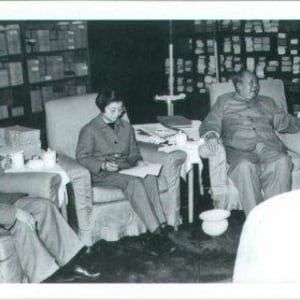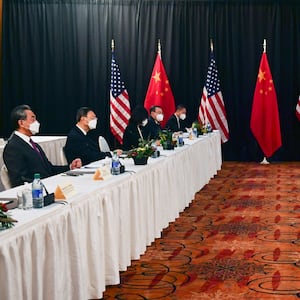A fifty-year anniversary is usually reason enough to throw a party. But this week, little champagne will be spilled to mark an event that changed the world – former President Richard Nixon’s historic trip to China in 1972.
Nixon became the first, but certainly not the last, U.S. president to visit the mainland while in office. His diplomatic gamble, one preceded by decades of little-to-no contact, ultimately set the stage for a resumption of diplomatic relations between the U.S. and China.
However, hindsight suggests that Nixon’s optimism about China was foolhardy, if not naïve. Some observers have since suggested that Nixon got conned by Mao Zedong. No doubt, Nixon’s China legacy remains mixed, just as many other China experts have misjudged Beijing’s intentions. That might explain why this momentous anniversary is unlikely to garner much attention.
ADVERTISEMENT
Nevertheless, there are important lessons to be gleaned from Nixon’s trip to what was once known as Peking. One is that the Chinese have almost always been upfront and direct about the issues they most care about, Taiwan among them. Even when the Chinese have been silent on certain matters, their message and often their intentions were clear, at least to those willing to listen. The same holds true today.
Unfortunately, President Biden’s China policy largely remains a mystery to the American people and to Beijing. To get things right, Biden needs to learn from Nixon’s mistakes and behave more, not less, like China. Put differently, Washington needs to finally shoot straight with Beijing.
Nixon’s decision about whether and how to engage with China closely mirrors Biden’s current calculus. Nixon’s trip occurred months before a consequential election and prior to his meeting with Mao only one-third of Americans approved of Nixon’s dealings with China. Less than half approved of his job performance. Nixon needed a win, but charming Mao was risky, as other polling revealed that the most common terms used by Americans to describe the Chinese people were “ignorant,” “sly,” and “treacherous.”
Before Nixon’s fateful voyage, foreign policy realists had little cause for concern. Writing in Foreign Affairs in 1967, Nixon warned that “rushing to grant recognition to Peking, to admit it to the United Nations and to ply it with offers of trade” would only “serve to confirm its rulers in their present course.” Nixon remarked that, “a policy of firm restraint, of no reward,” could “persuade Peking that its interests could be served only by accepting the basic rules of international civility.”
Nixon then turned around and did the opposite.

President Richard Nixon holds his chopsticks in the ready position as Premier Chou En-lai (left) and Shanghai Communist Party leader Chang Chun-chiao reach in front of him for some tidbits at the beginning of the farewell banquet here.
Bettmann/Getty ImagesDuring their only face-to-face meeting in China, Nixon and Mao avoided controversial topics, choosing instead to talk around the major issues that existed between the two nations. The real heavy lifting was left to Henry Kissinger, who by his own admission knew little of China or its history. Unsurprisingly, mistranslations and misunderstandings contributed greatly to Kissinger’s misbegotten strategy as he hashed out the now infamous Shanghai Communique.
For instance, at one pivotal point in the negotiations, China’s Foreign Minister Zhou Enlai referred to America as “the ba.” Kissinger was told this phrase meant “America is the leader,” when in actuality the term ba, which dates back to China’s “Warring States” period, more closely translates to “tyrant.” Beyond this and other miscommunications, China never wavered in its demands. On Taiwan, Nixon and Kissinger re-affirmed their “interest in a peaceful settlement” to the long-standing issue. Left unsaid was that prior to his arrival in Peking, Nixon, as a goodwill gesture, had ordered the withdrawal of some U.S. forces from Taiwan.
However, Kissinger later remarked in his book, On China, that Mao was emphatic in declaring that “Beijing would not foreclose its option to use force over Taiwan,” and indeed “expected to have to use force someday, [even in] a hundred years.”
The reason Nixon violated his self-imposed restraint had more to do with his re-election than realpolitik. The Nixon administration believed that conceding on Taiwan would convince Mao to “slow down the provision of aid” to China’s allies in North Vietnam, as well as persuade China to “encourage Hanoi to make a deal with the United States” to end the war, which was weighing on Nixon’s ratings. Nevertheless, at no point did Mao’s support for the North Vietnamese waver, even while he recognized the link Nixon made between that issue and Taiwan.
Kissinger thus learned that “in foreign policy you never get paid for services already rendered,” and Nixon’s graceful exit from Vietnam never came to be.
The effects of Nixon’s trip linger today. Sure, liberal internationalists and realists alike argue that engagement yielded positive benefits, including pulling China out of the Soviet Union’s sphere of influence. For many observers, Nixon’s trip and the subsequent breakdown of U.S.-China relations are considered either one giant missed opportunity or the logical culmination of an anarchic international system.
The reality is somewhere in between. America’s complicated history with China is not simply a story about broken promises or serial misjudgments. Rather, it reflects a failure of American presidents to listen to what China’s leaders have been saying for decades – namely, that they had little interest in modeling themselves after the West—while also recognizing that Beijing intended to stay true to its word.
The similarities to Nixon’s era do not end there, even as China’s ambitions remain very much the same as they were in the early '70s.
In releasing its Indo-Pacific strategy this month, the White House emphatically denied that it was a “China policy.” Instead, officials argued that the strategy simply recognizes the Indo-Pacific as a “particularly intense region of competition,” albeit without referencing the actual competitor—China. White House officials have also sought to jettison the term “extreme competition” when describing U.S.-China relations, focusing instead on establishing “guardrails” in the relationship. That is despite scant evidence that Beijing is also seeking guardrails to bound the competition. This Nixonian redux, in which the Biden administration won’t say what it means or mean what it says, explains why the Biden administration has achieved so little progress in its dealings with Beijing.
Ultimately, the American public rewarded Nixon for his China gambit, and his polling greatly improved. He later won a landslide victory in the 1972 election, in part because his outreach to Mao was seen as a decisive action intended to split the Communist bloc. Certainly, Biden could benefit from a similar polling bump, as a recent CBS poll revealed that six in ten Americans disapprove of his approach to China. In crafting a clear-eyed China policy, one that does not tiptoe around sensitive issues and that recognizes competition is a means, not an end, Biden could potentially match Nixon’s boldness without repeating his many mistakes.
Before his death, Nixon privately acknowledged that he had misjudged China and its leaders and, in one particularly blunt remark, he stated that his policies “may have created a Frankenstein’s monster.” For their part, Americans have been told for decades that engagement with Beijing would yield positive dividends, such as economic liberalization and improvements in human rights. Neither came to pass.
To be fair, America’s hopes for China may have been and could very well remain woefully unrealistic. But, as we mark the week that changed the world, President Biden would be wise to embrace the lessons of Nixon’s China legacy. Putting forward a China policy that is open, honest, and upfront with both China and the American people would be as good a place to start as any.







